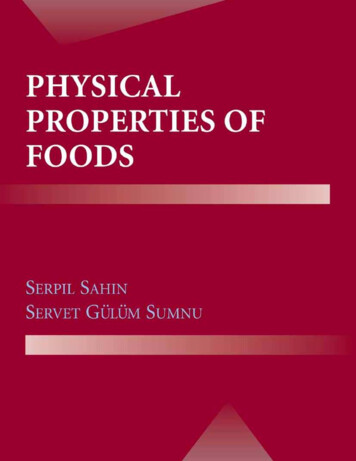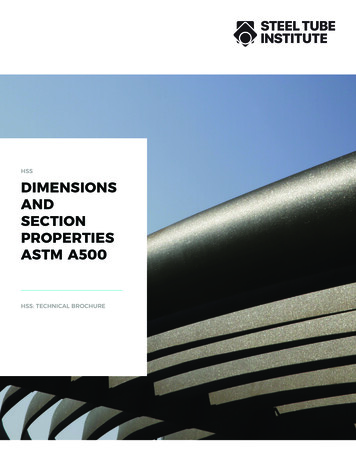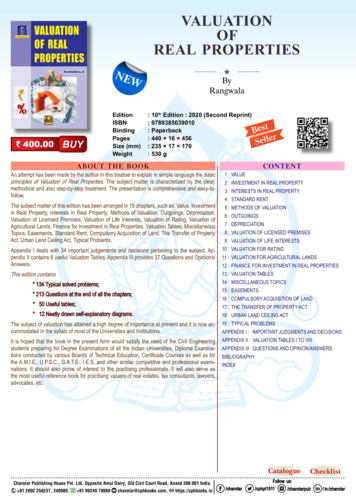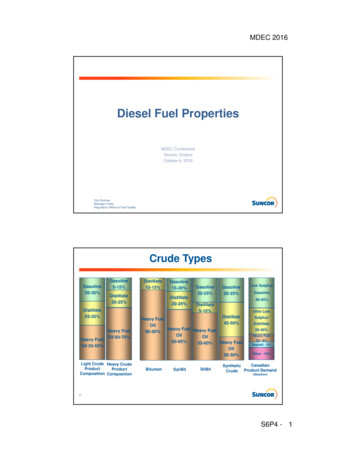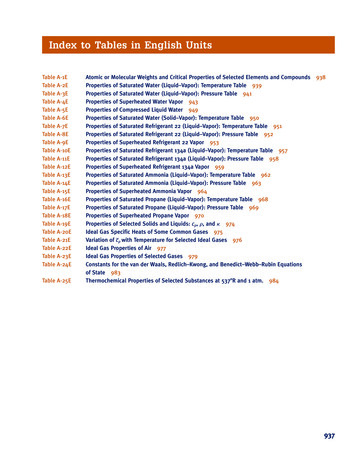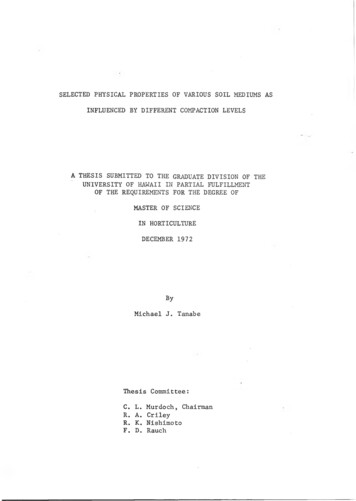
Transcription
SELECTED PHYSICAL PROPERTIES OF VARIOUS SOIL MEDIUMS ASINFLUENCED BY DIFFERENT COMPACTION LEVELSA THESIS SUBMITTED TO THE GRADUATE DIVISION OF THEUNIVERSITY OF HAWAII IN PARTIAL FULFILLMENTOF THE REQUIREMENTS FOR THE DEGREE OFMASTER OF SCIENCEIN HORTICULTUREDECEMBER 1972ByMichael J. TanabeThesis Committee:C.R.R.F.L.A.K.D.Murdoch, ChairmanCrileyNishimotoRauch
We certify that we have read this thesis andthat in our opinion it is satisfactory in scope andquality as a thesis for the degree of Master ofScience in Horticulture.THESIS COMMITTEE0---- -7Chairman
iiACKNOWLEDGMENTSThe author wishes to express his sincere appreciation to Dr. G.Uehara and Mr. R. Watanabe for their helpful assistance.Appreciationis also extended to the Hawaii Turfgrass Association and the AgricultureEngineering Department for their valuable assistance with theconstruction of the hydraulic press.Special thanks are extended toMr. Glenn Moriraoto and Miss Marsha Fujii for their helpful assistance.Finally the author wishes to express his sincere appreciation toMr. George Tai See for his unselfish time and valuable assistance.
iliTABLE OF CONTENTSPageACKNOWLEDGMENTS. iiLIST OF T A B L E S . ivLIST OF ILLUSTRATIONS.vINTRODUCTION.1REVIEW OF L I T E R A T U R E .3MATERIALS AND METHODS .15M e d i u m s . 15Compaction. '19Hydraulic Conductivity .23Soil Bulk D e n s i t y . 27Total Porosity.30Soil Moisture Content .30Analysis of D a t a .30RESULTS AND DISCUSSION.32SUMMARY.60A P P E N D I X .62BIBL I OG RA P HY . 64
ivLIST OF TABLESTablePage1PARTICLE SIZE DISTRIBUTION OF UNSIEVED VOLCANITE .2PARTICLE SIZE DISTRIBUTION OF BEACH S A N D . 173PARTICLE SIZE DISTRIBUTION OF LOAMITE4PERCENT MOISTURE CONTENT BY WEIGHT OF THESOIL MIXES WHEN SATURATED AND DURING C O M P A C T I O N . 315BULK DENSITY AND HYDRAULIC CONDUCTIVITY OFVARIOUS SOIL MIXTURES AS INFLUENCED BYCOMPACTION LEVEL AND PERCENT OF SOIL AMENDMENTSINCLUDED IN THE MIXTURE (AVERAGE OF3 REPLICATIONS).416BULK DENSITY AND HYDRAULIC CONDUCTIVITY VALUES ASAFFECTED BY DIFFERENT PERCENTAGES OF AMENDMENTSFOR DIFFERENT MEDIUMS. DATA ARE AVERAGES OVERALL COMPACTION LEVELS .1718447BULK DENSITY AND HYDRAULIC CONDUCTIVITY VALUES ASAFFECTED BY COMPACTION FOR DIFFERENT AMENDMENTS.DATA ARE AVERAGES OVER ALL PERCENT A M E N D M E N T S .468BULK DENSITY AND HYDRAULIC CONDUCTIVITY VALUES AS AFFECTEDBY COMPACTION WITH DIFFERENT PERCENTAGES OF AMENDMENTS.DATA ARE AVERAGES OVER ALLMEDIUMS. 47AppendixTable12ANALYSIS OF VARIANCE FOR EFFECTS OF COMPACTION ONBULK DENSITY AND HYDRAULIC CONDUCTIVITY OFVARIOUS SOIL M I X T U R E S .62TOTAL POROSITY FOR VARIOUS MEDIUMS AS INFLUENCEDBY DIFFERENT COMPACTIONLEVELS .63
J .VLIST OF ILLUSTRATIONSFigurePage1MODIFIED HYDRAULIC PRESS USED TO COMPACT THE MEDIUMS.212SCHEMATIC DIAGRAM OF APPARATUS USED AS A PER IEAMETER.253DIAGRAM OF THE CONSTANT-HEAD SYSTEM USED TODETERMINE HYDRAULIC CONDUCTIVITY .29RELATION BETWEEN COMPACTION AND BULK DENSITYFOR BEACH SAND, VOLCANITE AND WAHIAWA SOIL .35RELATION BETWEEN COMPACTION AND HYDRAULIC- CONDUCTIVITYFOR BEACH SAND, VOLCANITE AND WAHIAWA SOIL .37456RELATION BETWEEN COMPACTION AND BULK DENSITY FORMEDIUMS CONSISTING OF WAHIAWA SOIL AND A PERCENTAGEOF EITHER BEACH SAND, VOLCANITE, OR LOAMITE.FIGURES 6a , 6B, AND 6C CONSIST OF RESPECTIVELY25%, 50% AND 75% A M E N D M E N T S . 507RELATION BETWEEN PERCENT AMENDMENTS BY VOLUME ANDHYDRAULIC CONDUCTIVITY AT 44 PSI FOR MEDIUMSCONTAINING DIFFERENT PERCENTAGES OF EITHER BEACHSAND, VOLCANITE, OR L O A M I T E . 528RELATION BETWEEN PERCENT AMENDMENTS BY VOLUME ANDBULK DENSITY AT 44 PSI FOR MEDIUMS CONTAININGDIFFERENT PERCENTAGES OF EITHER BEACH SAND,VOLCANITE, OR LOAMITE .55RELATION BETWEEN COMPACTION AND HYDRAULICCONDUCTIVITY FOR MEDIUMS CONSISTING OF WAHIAWASOIL AND A PERCENTAGE OF EITHER BEACH SAND,VOLCANITE, OR LOAMITE .589
INTRODUCTIONSoil compaction is a very serious problem encountered on golf courseputting greens, tees, and fairways.soil as follows:Alderfer (1951) describes compacted"It is a soil whose particles have been fitted togetherso closely that the openings or pores which remain between them are ofsuch a size, shape, and arrangement that the plumbing, ventilation, andheating system within the soil are out of order."A major influence of soil compaction on golf courses is vehicular orhuman traffic on the surface of the soil (Ferguson, 1950).Thisphenomenon, when present, will usually decrease the quality of theaffected area and increase the cost of maintenance.soil compaction would include:Attempts to curbdecreasing the flow of traffic on thecourse, cultivating compacted areas, and constructing critical areas ofthe course with compaction tolerant mediums.The most economical andpractical route would be the preparation of soil mixes with compactionresisting properties.Studies by Morgan (1966) and Smalley (1962) partially substantiatethe possibilities of using various soil amendments to decrease thedetrimental effects of soil compaction.Uehara (1970) also did some workconcerning the use of amendments readily available in Hawaii.Although this field of study is not a new one, Hawaii has manyproblems limiting the use of amendments proven acceptable in the mainlandstates.The foremost problem is an economical one involving the shippingof silica sand from the mainland U.S. to Hawaii.Silica sand is used asa major component for mixes by most of the mainland U.S. golf courses.
2Since there are no deposits of silica sand in the state, Hawaii has beensubstituting beach sand (90 % CaCO ) for silica sand with mediocreresults.Since it is not an inert material, undesirable characteristicslimit its potential as an equivalent to silica sand.beach sand may also be forbidden by late 1973.The dredging ofThis mandates the studyof a possible replacement or replacements for beach sand.Therefore, theobjective of this work is to evaluate some potential soil amendments thatare economically available in Hawaii for golf courses.
REVIEW OF LITERATURESoil CompactionSoil compaction results when an external pressure or environmentalcondition causes a unit area of soil to decrease in volume.Thisdecrease in volume may be due to the closer packing or rearrangement ofthe soil particles.On golf courses, external pressures would include traffic over thesurface of the soil by humans, golf carts, and maintenance equipment.The impact of golf balls and golf clubs on the surface of a given areaof soil also results in some compaction.The force of raindrops on the aggregates of certain soils may causethese aggregates to break down into smaller structures.This allows fora closer packing of the particles and essentially influences soilcompaction.The movement of water through the soil may destroyaggregates and initiate the rearrangement of the soil particles.Theparticles of some soils may also assume a flat, platy shape, and maybecome layered as with a brick wall (Alderfer, 1951).Soil moisture content also plays a significant role in soilcompaction.Gerard (1965) found that the strength of briquets wasincreased as moisture content was decreased to an optimum level.This/optimum level was found to be at a moisture content consisting of 2 to 3monomolecular layers of water.Lotspeich (1964) observed that a moisturecontent between 1 and 5 bars tension was optimum for maximum soil Brick-shaped piece of artificial stone.
4strength and compaction.Less water resulted in insufficient lubricationfor particle movement and more water interfered with the packingarrangements of the soil particles.Gerard and others (1962) alsoindicated that a slow rate of soil drying was an important factor incausing closer packing of soil particles.They suggested that thecohesive force of water molecules may have played a role in the closerpacking or bonding of the soil particles.Lotspeich (1964) determined conditions that were conducive tomaximum soil strength and compaction.He found that certain species ofclays, when present at an optimum level, increased compaction.He alsostated that two multicomponent mediums composed of several sized fractionswere more susceptible to compaction.His reasoning for this phenomenonwas that a multicomponent medium with secondary, tertiary, andquaternary grains permits tetrahedral packing with mutual contact of allgrains.The effects of compaction are usually detrimental to the quality ofthe turf in the affected area.Gill (1959) associated compaction with adecrease in the percentage of non-capillary pores, increased mechanicalstrength of the soil mass, poor plant growth, and under severe conditions,the deformation of the soil.Ferguson (1950) cited other adverse effects from soil compaction;the need for green-keepers to overwater the green in an effort to softenit, alteration of the soil structure such that air and water movement isimpeded, and sometimes layering of the soil due to top dressing.Ferguson (1959) also noticed that foot traffic on a given area of turfresulted in loss of vigor to the turf, an encroachment of weeds,infections by diseases, and infestation of algae.
5Johnson and Henry (1964) experimented with the effect of soilcompaction on corn seedling emergence.They noticed that unless thecompacted zone was maintained at a relatively high moisture content,the soil strength was high enough to delay or prevent the sproutemergence.A study to determine the association between soilcompaction and plant growth was pursued by Hopkins and Patrick (1969).Their work involved the combined effect of oxygen content and soilcompaction on root penetration.Their experiment results indicated thatroot penetration was apparently more restricted by mechanical impedancedue to compaction than by poor aeration.Several techniques can be used to determine soil compaction.Alderfer (1951) discussed the use of a probing instrument called apenetrometer, and a technique for the determination of permeability ofsoil to water and air.Terry and Wilson (1953) described the use of apenetrometer in their soil compaction studies.advantage of being a self-recording unit.Their instrument had theThe determination of soilbulk density also provides both laboratory and field estimations ofsoil compaction.The use of compacting devices has aided studies concerned with soilcompaction.Felt (1965) used an impact type of compactor considered tobe the standard method of the American Society for Testing andMaterials.Richards, Warneke and Weeks (1965) explained the use of theirmotor-driven, spring loaded compactor and the procedure used inpreparing soil cores for measuring physical properties.type of compactor was studied by Bruce (1955).Another impactHis unit could be usedsatisfactorily for small quantities of soil with the flexibility to
6produce a wide range of compaction energies.A modified aerifierspecially designed with legs and shoes to simulate human compaction wasdeveloped by Goss and Roberts (1964).This unit was able to exert amaximum of 17 psi on the surface of the soil (a 180 pound man wouldexert a pressure of about 6.7 psi when standing on one foot).Cooper and Nichols (1959) reviewed observations of:compaction asrelated to soil physical properties affecting plant growth, types offorces applied to the soil, measurement of pressure distribution in thesoil, effect of pressure on change in bulk density, and the breaking upof compacted layers.Control or prevention of further soil compaction after theconstruction of the turf area is usually difficult.Economics andpracticality usually discourage correction of this adverse condition.Therefore, the problem should be foreseen and preventative measuresundertaken.Various approaches to this problem have been studied.Kunze andothers (1957); Smalley and others (1962); Morgan and others (1966)approached this problem by working with various soil mixes possessingcompaction tolerant properties.McLeod and others (1966) concluded thatthe use of wider tires on tractors with air pressure as low as 4 psidecreased soil compaction and increased traction.Additional studiesdone by Wong (1967) involved the use of different wheels as they affectthe movement of soil particles.Soil-Water MovementKlute (1965) stated that the rate of movement of water through the
7soil is of considerable importance for agricultural and urban life.Heclaimed that the rate of water movement through the soil may affect themovement of water to the plant roots, the entry of water into the soil,the flow of water to drains and wells, and the evaporation of water fromthe soil surface.Several terms have been used to describe the movement of waterthrough the soil.Lewis and Powers (1938) defined water infiltration as"the rate of water entrance at the soil surface."Richards (1952)defined percolation as "a qualitative term applying to the downwardmovement of water through the soil."He also defined permeabilityqualitatively as "the quality or state of a porous medium relating tothe readiness with which such a medium conducts or transmits fluids.Quantitatively, permeability is the specific property designating therate or readiness with which a porous medium transmits fluids understandard conditions."Richards (1952) defined hydraulic conductivity as "the ratio of theflow velocity to the driving force for the viscous flow under saturatedconditions of a specified liquid in a porous medium.""Physical dimensions will depend on the equation selected to expressthe flow.The ratio v/i k, where v is the flow velocity of a specifiedliquid under saturated conditions, and i is the hydraulic gradient inthe Darcy equation, v ki."The movement of water through the soil may be Influenced by variousforces.Klute (1952) mentioned possible such forces as pressuregradient, and gravitational, adsorptive, and osmotic.He also mentionedthe possibility of electrical and thermal gradients which may affect the
8movement of water through the soil.The most significant change inwater movement through the soil is probably caused by soil compaction.Fireman and Bodman (1939) reported that applications of salineirrigation water produced an almost immediate increase in soil waterpermeability.Fireman (1944) extended his research in this area andfound that great decreases in saturated water permeability of soilsexamined may have been attributed to the early removal of electrolytes.This phenomenon was possibly the result of the gradual dispersion andrearrangement of the clay particles and also a reduction in size ofwater conducting pores.In general, he found that the lower the saltconcentration, the lower the soil permeability.Decreasing theelectrolyte content of the percolating water from 10,000 ppm to 40 ppmdecreased the permeability of a clay loam from 10.2 cm/hr to 7.3 cm/hrand a Yolo fine sandy loam from 2.8 cm/hr to .3 cm/hr.Fireman alsoobserved that some soils were hundreds of times more permeable to tapwater than they were to distilled water.His tap water containedapproximately 280 ppm of mixed salts of which 90% were sodium salts.Calcium is the principal adsorbed cation of the colloidal complexof most agricultural soils.The addition of sodium salts to tap watercauses a base exchange to take place and thereby initiate an exchangeof sodium ions for calcium ions with a resultant dispersion of the soilparticles.The presence of high salt content in the tap water tends tokeep the soil flocculated and moderately permeable even with a highsodium content in the water (Fireman, 1944).Further work was done by Reeve and Tamaddoni (1965) concerninghydaulic conductivity as affected by electrolyte concentration.They
9stated that the soil-water-movement could be increased in salt-affectedsoils by increasing the electrolyte concentration of the applied water.To facilitate the removal of excess salts or harmful exchangeablesodium, it was suggested that the water must move into and pass throughthe soil.This caused the soil-clay packets to contract, and therebyincreased the permeability of the soil to water.Waldron and Constantin (1968) noticed that saturating the soil withsodium chloride solution followed by decreasing concentrations of thesame salt resulted in a marked decrease of hydraulic conductivity.Theyexplained that the treatment may have caused an Increase in netrepulsion or swelling pressures between the clay platelets to influencethe weakening, swelling, or dispersion of the soil aggregates.Therefore,the aggregate failure may be influenced by internal swelling pressures,from local shearing stresses deforming the weakened aggregates, or acombination of both.Gardner, Mayhugh, Goertzer, and Bower (1959) claimed thatpermeability of a soil is directly related to pore-size distribution,which in turn depends upon the texture of the soil and the extent ofswelling of the clay fraction.They further stated that the effect ofa given amount of swelling upon permeability or difusity should dependto some extent upon the amount and kind of clay minerals in the soil andparticle size distribution of the non-swelling particles.Nelson and Baver (1940) discussed the movement of water through thesoil in relation to the nature of the pores.They mentioned thesignificance of the continuity of pores as it affects permeability.Laliberte and Brooks (1967) worked with the determination of saturatedpermeability of soils using a bubbling pressure technique.
10Other factors affecting the movement of water through the soil werediscussed by Wischmeier and Mannering (1965).Their data showed thatincreasing the content of decomposed and partially decomposed organicresidues substantially increased infiltration of water into most soils.DeJong (1966) found that the moisture content of the soil did notsignificantly affect the hydraulic conductivity of shrinking soils.However, hydraulic conductivity rapidly approached zero for non-shrinkingsoils with decreasing moisture content.DeJong discussed four stagesassociated with the shrinkage of natural clods and aggregates of highclay content.Although all the factors discussed are important, compaction may beconsidered one of the most influential factors governing the verticalmovement of water through the soil.Swartz and Kardos (1963) mentionedthe detrimental effects of compaction on the physical properties ofvarious soil mixtures at different moisture contents. Their dataindicated inadequate percolation rates after their mixture containing50% sand was compacted.Mixtures containing 70% sand were able tomaintain adequate percolation rates after compaction.However, thesemixtures were prone to excessively high percolation rates or insufficientavailable moisture status.PorosityBuckman and Brady (1967) defined pore space of a soil as, "thatportion occupied by air and water."The amount of pore space is strictlydependent on the arrangement of the solid particles.If the particlesare arranged close to each other, as with most sand and compacted soils,the total porosity is low.However, if a soil is not compacted and well
11aggregated, total porosity will be high.Vomocil (1965) stated that the geometry of the pore system of thesoil is just as complex as the solid phase.The pores may differ fromone another in shape, lateral dimensions, length, tortuosity, andcontinuity.This system of pores may be described as total porosity,volume percentage of large pores, or pore size distribution.' -There are essentially two types of pore spaces found in most soils.The large non-capillary pore spaces are called macropore spaces,whereas the smaller capillary pore spaces are called micropore spaces.The macropores are mainly instrumental in permitting the ready movementof air and percolating water.In contrast, the micropores greatlyimpede the movement of air and allow for only a slow movement of water.Lutz and Learner (1939) found that permeability of the separatesoil fractions increased exponentially with the size of the particles,and therefore, with the size of the pore spaces.They also observed thatswelling of the soil caused a decrease in its permeability to water dueto the clogging of the pore spaces for subsoils or finer fractions.Browning (1939) noticed that the volume of the soil increased when thesoil was wetted.This caused a decrease in volume of micropore spacesand likewise in infiltration rates.Nelson and Baver (1940) claimed that low porosity soils, such assandy soils, may have larger pore spaces with few small pore spacesdistributed between the large ones.This arrangement, which is usuallypresent in soils with a high volume of pores, rendered the macroporesless continuous.Soil compaction plays a very important role associated with the
12porosity of the soil.Davis (1952), in a study of golf course greens,found that there was a. strikingly smaller quantity of non-capillarypores in the upper part of the greens than the lower portions of thegreens, probably due to soil compaction.Voorhees and others (1966)stated that the average apparent pore diameter decreased with a decreasein aggregate diameter.Therefore, the reduction of non-capillary porespaces in the compacted zone may be a result of aggregates that have losttheir structure and were reduced to a smaller diameter.Particle-size DistributionDay (1965) stated that "the particle-size distribution of a soilexpresses the proportions of the various sizes of particles which itcontains.The proportions are commonly represented by the relativenumbers of particles within stated size classes, or by the relativeweight of such classes."The solid soil phase is constituted of individual particles oraggregates. The strength of these aggregates usually determines theability of that particular soil medium to tolerate severe soilcompaction.Meredith and Kohnke (1965) discussed microbial activity as itaffected the strength of the soil aggregates.They found that microbialactivity associated with the decomposition of organic matter in the soilencouraged greater strength of the soil aggregates.These aggregatesbecame more tolerant to the destructive forces of water accompanied bypoor wettability.Slow rates of wettability were associated withgreater stability of the soil aggregates.
13Amemiya (1965) associated soil aggregate size with moistureretention.He observed an increase in moisture retention of theNicollet silt loam medium as the aggregate size increased and concludedthat the moisture retention for that particular medium was a result of adifference in the relative pore size distribution between the within theaggregates.- -Soil compaction greatly influences the rearrangement of the soilparticles and, consequently, the amount of macropores and micropores.These pore spaces are essential for the mobility of air and water in thesoil.Bodman and Constantin (1965) studied the influence of particlesize distribution in soil compaction.They claimed that the greater thedifference in individual particle size of the mixes, the less will bethe bulk volume of that particle mix.This would probably allow forgreater soil compaction and a reduction in macropore spaces.Soil Moisture ContentWater or moisture content of the soil may be expressed as the ratioof the mass of water present in a sample to the mass of the sample afterit has been dried to a constant weight, or as the volume of waterpresent in a unit volume of the sample (Gardner, 1965).The factors that influence the capacity of soils to retainavailable water are:1) soil texture, 2) soil structure, 3) particle-sizedistribution, and 4) organic matter content (Salter and Williams, 1965).They found that soil texture was the basic factor determining the moisturecharacteristics of the soils.The moisture contents at field capacityand permanent wilting point increased as the soils became finer in
14texture.However, the medium textured soils held the greatest volumeof available water.Amemiya (1965) attributed compaction, organic matter content,aggregate stability, and type of clay mineral as factors influencingsoil moisture retention.He also mentioned that soil capillaryconductivity appeared to be a function of moisture content.Soil bulk density changes have been shown to produce marked changesin moisture characteristics of many soils.Hill and Sumner (1967)observed that moderate soil compaction resulted in an increase inmoisture content of the soil at a constant matric suction.However,severe soil compaction initiated a decrease in soil moisture content ata constant matric suction.Uehara (1970) found a definite correlation between compactabilityof a kaolinitic clay and moisture content of that particular medium.Maximum compaction expressed as bulk density occurred at approximately36% moisture content by weight of the clay soil.A possible explanationfor this phenomenon is that an optimum moisture content is necessary tolubricate the soil particles and induce closer packing of theseparticles.Moisture content above this optimum level would notincrease the compactability of the soil medium because of theincompressability of water.
MATERIALS AND METHODSFour different mediums and several soil mixtures were used in thisstudy to determine their ability to tolerate surface applied soilcompaction.Tolerance to soil compaction was based on the results ofvarious measurements made after the medium was exposed to compactiveforces.These measurements Included soil bulk density and soil hydraulicconductivity.A soil mix was considered tolerant to soil compaction ifthe hydraulic conductivity values were within the limits specified by theUnited States Golf Association (inch to inch and a half per hour).Soilbulk density was used as a measurement of the degree of soil alterationcaused by compactive forces.Other measurements made were total porosityand particle size distribution.Wahiawa soil, Loamite, and beach sand were selected for this studybecause of their present availability and usage on most golf courses andturfgrass areas.Volcanite is being used in limited quantities by afew golf courses and may be acceptable in the future when the dredging ofbeach sand is prohibited.Medium combinations have great potential for usage on turfgrassareas exposed to a high degree of human and vehicular traffic.Theyhave the advantage of possessing several desirable propertiescontributed by each medium component.In contrast, individual mediumsare limited to the properties they possess.MediumsThe mixtures used in this study contained different percentages byvolume of the Wahiawa soil.This kaolinltic clay was used as a
16component for all mixtures because of its availability and desirableproperties.The mixtures used were as follows:soil:Volcanite;soil:sand; and soil:Loamite.The Wahiawa soil is a clay soil containing kaolinite as itsdominant mineral.This soil, if not compacted, has good structure andis very permeable to water.Compaction at an optimum moisture contentwill alter the soil's structure sufficiently to severely impede themovement of water.It is resistant to erosion and will not crack whendried as with the Dark Magnesium clays.Water retention is good.It isusually moderately acid with a pH of approximately 4.0-5.5 and low infertility.The soil used in this study was obtained from a private home locatedin Wahiawa, Hawaii.Most of the soil was taken from the upper twelveinches of the soil profile.The organic matter content was relativelyhigh due to prior addition of foliage into the soil.Volcanite is a commercial product obtained from the Puu Waa Waacinder cone on the island of Hawaii.minerals.Salinity is negligible and its cation exchange capacity isapproximately 6 meq./lOO gm.pH is about 8.0.is low.It is composed mainly of TrachyteSilica content is approximately 62% andPhysically, its structure is weak and fertility levelPresently it is receiving attention as a component of asynthetic soil for nursery crops and as a possible substitute for beachsand on golf courses.The Volcanite used for this study was tested both in the sieved andunsieved state. It was obtained from the Kunia Golf Course in Wahiawa.The sieved state consisted of particle sizes between .0331-.0098 inches
17or .850-.250 millimeters.The unsieved Volcanite consisted of a diversedistribution of particle sizes (Table 1).The bulk of the particleswere greater than .850 mm and less than .106 mm.Table 1.Particle size distribution of unsieved VolcaniteInchesmm% by 0654.618.06.03.45.512.5Cumulative % by wt.54.672.678.682.087.5100.0Beach sand is presently Hawaii's substitute for silica sand.It isa coarse textured medium with no structure and has a very low waterholding capacity.Fertility level is low, and the dominant mineral iscalcium carbonate.The beach sand used for this study was obtained from the Kunia GolfCourse in Wahiawa.It was alkaline and had a pH of 8.1.The particlesize distribution was as shown in Table 2.Table 2.Particle size distribution of beach sandInchesmm .0787.0787-.0331.0331-.0165.0165-.0098.0098-.0041 2.0002.000-.850.850-.
MEDIUMS CONSISTING OF WAHIAWA SOIL AND A PERCENTAGE OF EITHER BEACH SAND, VOLCANITE, OR LOAMITE. FIGURES 6 a, 6B, . problems limiting the use of amendments proven acceptable in the mainland states. The for

